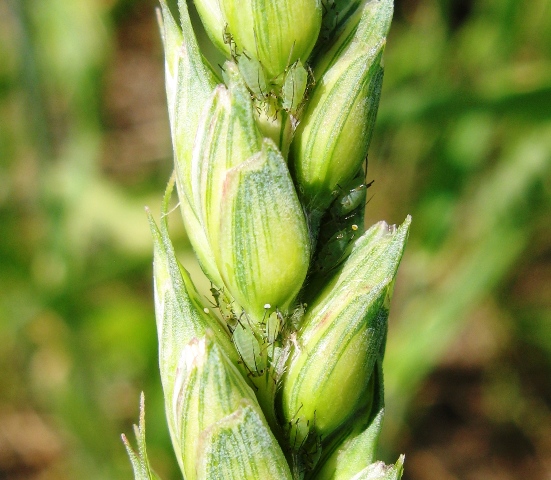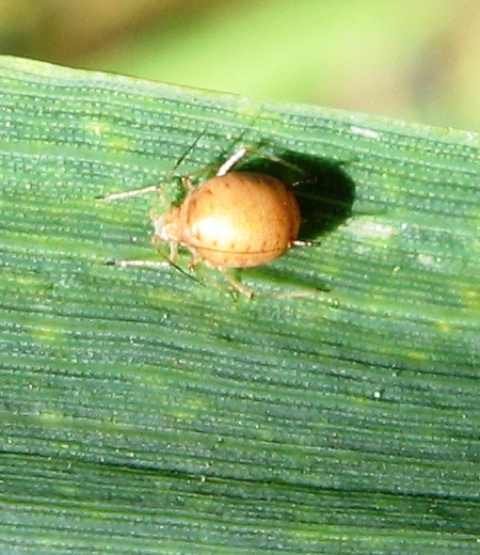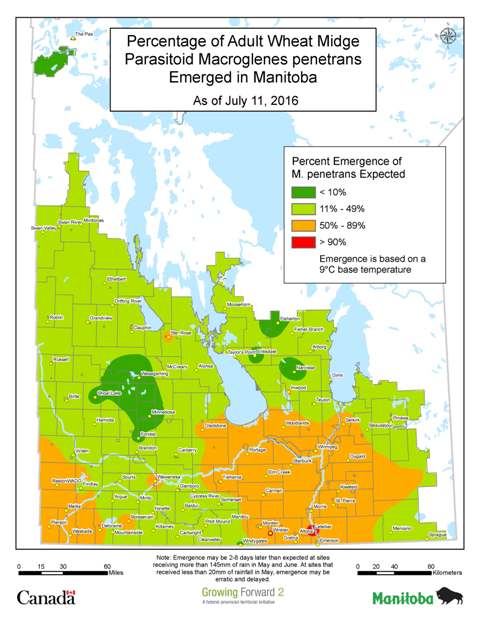Manitoba Insect & Disease Update
Issue 9: July 13, 2016
Summary
Insects: Levels of alfalfa weevil larvae are rapidly declining in some alfalfa fields as the larvae mature to pupae. Pea aphid levels are still a concern in some pea fields. Aphid levels are being monitored carefully in some cereal fields; high levels of natural enemies have also been noted in some of these fields and may be helping to regulate levels below economic thresholds.
Plant Pathogens: The current weather conditions are favorable to disease development. If fungicides are being considered for management of diseases in various field crops, a recommended rate of fungicides should be used.
Blackleg was reported in canola. Root and crown rot in wheat was detected in a sample submitted to Manitoba Agriculture’s Crop Diagnostic Lab. Root rot, bacterial blight and brown spot in soybeans continue to be reported in soybeans.
Aphids in Cereals
You will often find aphids clustered on some plants; adults with the young nymphs nearby. Aphids develop through their stages very rapidly, so when monitoring all aphids are counted, not just larger ones. Parasitized aphids (Fig. 2), known as aphid mummies will look swollen and discoloured and are not counted.


Fig. 1. Aphids on wheat Fig. 2. Aphid mummy
The economic threshold on cereals is 10-15 aphids /stem prior to the soft dough stage. Research has found that after the early-dough stage insecticide treatments were not cost-effective.
Scouting tips: It is quite normal to find some plants with 10-15 or more per stem, but if there are a lot of plants around these with none or very few per stem, than the field would be below the economic threshold. If you can randomly pick plants (not looking specifically for plant with aphids to do counts on), and on average be above 10-15 per stem, and not yet at the soft dough stage, that is the point when insecticides become economical. Aim to sample at least 20 stems for aphids; selecting 5 stems from each of at least 4 areas of the field is a good sampling plan.
Factors regulating aphid populations: Sometimes aphid populations will increase, but other times populations will stabilize or decrease due to predators and parasites, diseases, or heavy rains which can reduce a population. So if a heavy rain goes through, sometimes it is good to reassess a population. And if natural enemy levels are high, it is good to assess whether levels of aphids are possibly declining.
Soil moisture levels and aphids in cereals: As another consideration, research on English grain aphid in winter wheat found that there was a greater yield reduction for a given aphid density when plants were grown under water stress versus nonstress conditions. They concluded that “therefore, the water status of the plant should be considered to determine an economic injury level for S. avenae infesting winter wheat” (Environmental Entomology. 1988. Pp. 596-602). This may be difficult to do, but does show that a given level of aphid feeding on cereals is likely to reduce yields more when plants are growing under water deficits, which is generally not the case this year.
Emergence of wheat Midge
The following map shows the percent of wheat midge that are expected to have emerged, based on models using degree days to calculate percent emergence. In some areas of Central and Southwest Manitoba, about 50 to 90% of the wheat midge are expected to have emerged (yellow on the map). In many areas of Manitoba about 10 to 50% of wheat midge are expected to have emerged.

A reminder that wheat that has already produced anthers is no longer susceptible to feeding by wheat midge. Even if adults are still active in these more advanced fields, the larvae will not feed on the grain.
Note: Emergence may be 2–8 days later than expected at sites receiving more than 145 mm rain in May and June.
The prime parasitoid of the wheat midge, Macroglenes penetrans, is also emerging. The map below shows its emergence. Note how well its emergence is synchronized with that of the wheat midge.

Insect Monitoring Programs
Bertha armyworm: So far cumulative trap counts for bertha armyworm are mainly in the low risk range (less than 300). Out of 83 traps, 74 are currently in the low risk range, and 9 are in the uncertain risk range (300 to 900 moths). No traps are in the moderate risk (900 - 1,200 moths) or high risk range (1,200 plus moths). Most of the counts in the uncertain risk range are in the western regions of Manitoba. Highest counts, as of July 13, are:
| Location | Count |
|---|---|
| Durban (NW) | 885 |
| Benito (NW) | 569 |
| Lena (C) | 482 |
| Kenville (NW) | 462 |
| Minto (SW) | 445, 357 |
| Tummel (NW) | 376 |
| Roblin (NW) | 368 |
| Dunrea (C) | 303 |
For uncertain risk the precaution we use is that economic levels of larvae may not be widespread, but fields that were particularly attractive to egg-laying females could have higher levels. Check your fields.
Note that there are times when we get to these levels, and no economic levels of larvae occur.
Also, higher levels of larvae, should they occur, may or may not be in the fields that the traps are in.
Also, higher levels of larvae, should they occur, may or may not be in the fields that the traps are in.
Compiled by:
John Gavloski, Entomologist Pratisara Bajracharya, Field Crop Pathologist
Manitoba Agriculture Manitoba Agriculture
Phone: (204) 745-5668 Phone: (204) 750-4248
To report observations on insects or plant pathogens that may be of interest or importance to farmers and agronomists in Manitoba, please send messages to the above contacts.
To be placed on an E-mail list so you will be notified immediately when new Manitoba Insect and Disease Updates are posted, please contact John Gavloski .
